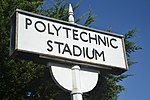Chiswick Bridge
Chiswick Bridge is a reinforced concrete deck arch bridge over the River Thames in West London. It is one of three bridges opened in 1933 as part of an ambitious scheme to relieve traffic congestion west of London. The structure carries the A316 road between Chiswick on the north bank of the Thames and Mortlake on the south bank. The bridge is built on the site of a former ferry. It is 606 feet (185 m) long and faced with 3,400 tons of Portland stone. When the 150-foot (46 m) central span opened it was the longest concrete span over the Thames. The bridge is well known for its proximity to the end of The Championship Course, the stretch of the Thames used for the Boat Race and other rowing events.
Excerpt from the Wikipedia article Chiswick Bridge (License: CC BY-SA 3.0, Authors).Chiswick Bridge
Chiswick Bridge, London Mortlake (London Borough of Hounslow)
Geographical coordinates (GPS) Address External links Nearby Places Show on map
Geographical coordinates (GPS)
| Latitude | Longitude |
|---|---|
| N 51.473055555556 ° | E -0.26972222222222 ° |
Address
Chiswick Bridge
Chiswick Bridge
SW14 7SA London, Mortlake (London Borough of Hounslow)
England, United Kingdom
Open on Google Maps









